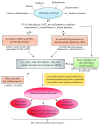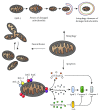Biomarkers of Oxidative Stress in Metabolic Syndrome and Associated Diseases
- PMID: 31191805
- PMCID: PMC6525823
- DOI: 10.1155/2019/8267234
Biomarkers of Oxidative Stress in Metabolic Syndrome and Associated Diseases
Abstract
Metabolic syndrome (MS) represents worldwide public health issue characterized by a set of cardiovascular risk factors including obesity, diabetes, dyslipidemia, hypertension, and impaired glucose tolerance. The link between the MS and the associated diseases is represented by oxidative stress (OS) and by the intracellular redox imbalance, both caused by the persistence of chronic inflammatory conditions that characterize MS. The increase in oxidizing species formation in MS has been accepted as a major underlying mechanism for mitochondrial dysfunction, accumulation of protein and lipid oxidation products, and impairment of the antioxidant systems. These oxidative modifications are recognized as relevant OS biomarkers potentially able to (i) clarify the role of reactive oxygen and nitrogen species in the etiology of the MS, (ii) contribute to the diagnosis/evaluation of the disease's severity, and (iii) evaluate the utility of possible therapeutic strategies based on natural antioxidants. The antioxidant therapies indeed could be able to (i) counteract systemic as well as mitochondrial-derived OS, (ii) enhance the endogenous antioxidant defenses, (iii) alleviate MS symptoms, and (iv) prevent the complications linked to MS-derived cardiovascular diseases. The focus of this review is to summarize the current knowledge about the role of OS in the development of metabolic alterations characterizing MS, with particular regard to the occurrence of OS-correlated biomarkers, as well as to the use of therapeutic strategies based on natural antioxidants.
Figures



Similar articles
-
Metabolic Syndrome as a Multifaceted Risk Factor for Oxidative Stress.Antioxid Redox Signal. 2017 Mar 20;26(9):445-461. doi: 10.1089/ars.2016.6756. Epub 2016 Jul 14. Antioxid Redox Signal. 2017. PMID: 27302002 Review.
-
Metabolic Syndrome and Oxidative Stress: A Complex Relationship.Antioxid Redox Signal. 2017 Mar 20;26(9):429-431. doi: 10.1089/ars.2016.6929. Epub 2016 Dec 19. Antioxid Redox Signal. 2017. PMID: 27796142
-
Oxidative stress in metabolic diseases: current scenario and therapeutic relevance.Mol Cell Biochem. 2023 Jan;478(1):185-196. doi: 10.1007/s11010-022-04496-z. Epub 2022 Jun 28. Mol Cell Biochem. 2023. PMID: 35764861 Review.
-
Obesity and oxidative stress: potential roles of melatonin as antioxidant and metabolic regulator.Endocr Metab Immune Disord Drug Targets. 2014;14(3):159-68. doi: 10.2174/1871530314666140604151452. Endocr Metab Immune Disord Drug Targets. 2014. PMID: 24934925 Review.
-
Effects of Polyphenolic Derivatives on Heme Oxygenase-System in Metabolic Dysfunctions.Curr Med Chem. 2018;25(13):1577-1595. doi: 10.2174/0929867324666170616110748. Curr Med Chem. 2018. PMID: 28618991 Review.
Cited by
-
The association between bilirubin levels, and the incidence of metabolic syndrome and diabetes mellitus: a systematic review and meta-analysis of cohort studies.Clin Diabetes Endocrinol. 2024 Jan 10;10(1):1. doi: 10.1186/s40842-023-00159-0. Clin Diabetes Endocrinol. 2024. PMID: 38195551 Free PMC article. Review.
-
Artisanal Gem Mining in Brazil: Evaluation of Oxidative Stress and Genotoxicity Biomarkers.Int J Environ Res Public Health. 2024 Jul 3;21(7):871. doi: 10.3390/ijerph21070871. Int J Environ Res Public Health. 2024. PMID: 39063448 Free PMC article.
-
The association between visceral adiposity index and leukocyte telomere length in adults: results from National Health and Nutrition Examination Survey.Aging Clin Exp Res. 2022 Sep;34(9):2177-2183. doi: 10.1007/s40520-022-02168-y. Epub 2022 Aug 6. Aging Clin Exp Res. 2022. PMID: 35933575
-
Molecular and pathophysiological relationship between obesity and chronic inflammation in the manifestation of metabolic dysfunctions and their inflammation‑mediating treatment options (Review).Mol Med Rep. 2024 Jun;29(6):95. doi: 10.3892/mmr.2024.13219. Epub 2024 Apr 12. Mol Med Rep. 2024. PMID: 38606791 Free PMC article. Review.
-
Salivary biomarkers: novel noninvasive tools to diagnose chronic inflammation.Int J Oral Sci. 2023 Jun 29;15(1):27. doi: 10.1038/s41368-023-00231-6. Int J Oral Sci. 2023. PMID: 37386003 Free PMC article. Review.
References
Publication types
MeSH terms
Substances
LinkOut - more resources
Full Text Sources
Other Literature Sources
Medical

